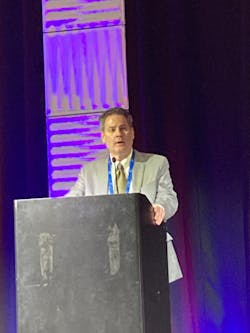Shell, Petronas and Reliance develop O-PAS testbeds
Several well-known and new members of the Open Process Automation Forum presented their usual Open Process Automation Standard (O-PAS) progress report on Feb. 7 and 9 at the ARC Industry Forum in Orlando, Fla.
In fact, Shell has been implementing its own O-PAS testbed for more than eight months, and performed its factory acceptance test (FAT) this past December.
“We started by testing gateways that will allow us to communicate with O-PAS systems on the external side of our current DCS, and results were promising. So, we’re continuing to work with the testbed, and have produced a greenfield O-PAS system that will be integrated with the gateway on the existing DCS,” says Jacco Opmeer, co-chair of the OPAF and DCS subject matter expert at Shell, during a Feb. 9 video call at the ARC event. “The small greenfield system comprises distributed control nodes (DCN), O-PAS I/O and an O-PAS advanced computing platform (ACP), all connected to an O-PAS open connectivity framework (OCF). We also finalized the FAT recently, and we’re presently joining both parts of our testbed, so they can migrate to a combined system. We’ll continue testing functionality on both sides of the OCF backbone. We’ll also move some applications from existing systems to an ACP defined by O-PAS, so we can understand its implications, help the standard develop further, and find out where we can do more.
“In the coming year, we’ll continue testing, and see whether we can start adding some certified products. We’re asking our suppliers to get their products O-PAS-certified because we could save on some testing. The tests and trials have already pushed some O-PAS elements into projects, but we have to keep stepping forward, so we don’t fall back onto old, familiar habits. For example, we’ve already done a successful UniversalAutomation.org (UAO) runtime test on a field trial, and we want to further explore the IEC 61499 standard that UAO is based on. We do all this because we believe that standards of standards like O-PAS will help us disclose data, and bring real time functionality to all layers in our systems, which will help us achieve our business goals”
Petronas and Reliance weigh in
Not surprisingly, some of the most earnest O-PAS initiatives are coming from regions with younger oil and gas facilities and histories and shorter histories in process control, such as the Middle East and Asia/Pacific.
“The future of distributed control is O-PAS. Petronas is committed to making O-PAS happen, so we’re building a testbed with 200 I/O, including 100 analog inputs and outputs, and 100 soft-signal I/O,” says Sharul Rashid, Instrument & Control (I&C) custodian engineer for Group Technical Solutions (GTS) and Project Delivery & Technology (PD&T) at Petroliam Nasional Berhad in Kuala Lumpur, Malaysia. He’s also co-chair of OPAF’s certification working group. “We will be deploying the testbed at our Institute Technical Petronas (INSTEP) training plant in Terengganu, so we can bring in technicians to make mistakes and learn.”
Zhafran Aziz, I&C staff engineer for GTS and PD&T at Petronas, has been working part-time on the testbed, which is being built in collaboration with Yokogawa, and will even test Intel’s O-PAS distributed control node (DCN) prototype. Construction began at the beginning of 2022, and the testbed completed its preliminary FAT this past December. Installation is scheduled for June and July, and the testbed will be handed over to INSTEP later this year.
“We had some issues during testing and some items we didn’t expect, but we’re hoping to solve all of them during the next and final FAT in March,” says Zhafran. “These efforts will be worth it because we know the value of O-PAS is that it can solve the problem of having to rip and replace so much equipment every 10-15 years.”
Likewise, in some late-breaking news, Reliance Industries Ltd. reported Feb. 9 that it’s implementing an O-PAS testbed for a trial run in one of the refinery sites at its Jamnagar facility in Gujarat, India. This project is being integrated by Yokogawa, and planned in different phases from testbed to field trial, while its FAT will be done at Yokogaw’s Bangalore office. The testbed is expected to be delivered at the site in June.
“We’ve checked on the testing and use cases that ExxonMobil and others have done, but we want some firsthand O-PAS experience, too,” says Kartik Fojdar, VP and head of the Instrumentation Centre of Excellence at Reliance. “We’ve tested and used traditional distributed control systems (DCS) at the highest rate in Asia, and they face the usual lifecycle and obsolescence issues. Currently, software and hardware are linked together. For example, front-end upgrades lead to back-end firmware upgrades, which leads to shutdown requirements. This is a time-consuming and costly affair.
“With O-PAS, if a hardware component such as an I/O or controller has a problem, we can upgrade it with any make and model we choose. This makes it feasible to use best-in-class components in one overall system, which will reduce costs. Plus, we won’t have to shut down our whole system, so we can also do upgrades at any time. This gives us a lot more flexibility, which is very important in our industry. The bottom line is lifecycle costs of the system will decrease and system reliability will improve. Thus, O-PAS has potential to address the majority of our pain points. We’re also likely to have the only O-PAS testbed in India, so we can make other end users and OEMs aware of it, and spread its message in our part of the world.”
About the Author

Leaders relevant to this article:


